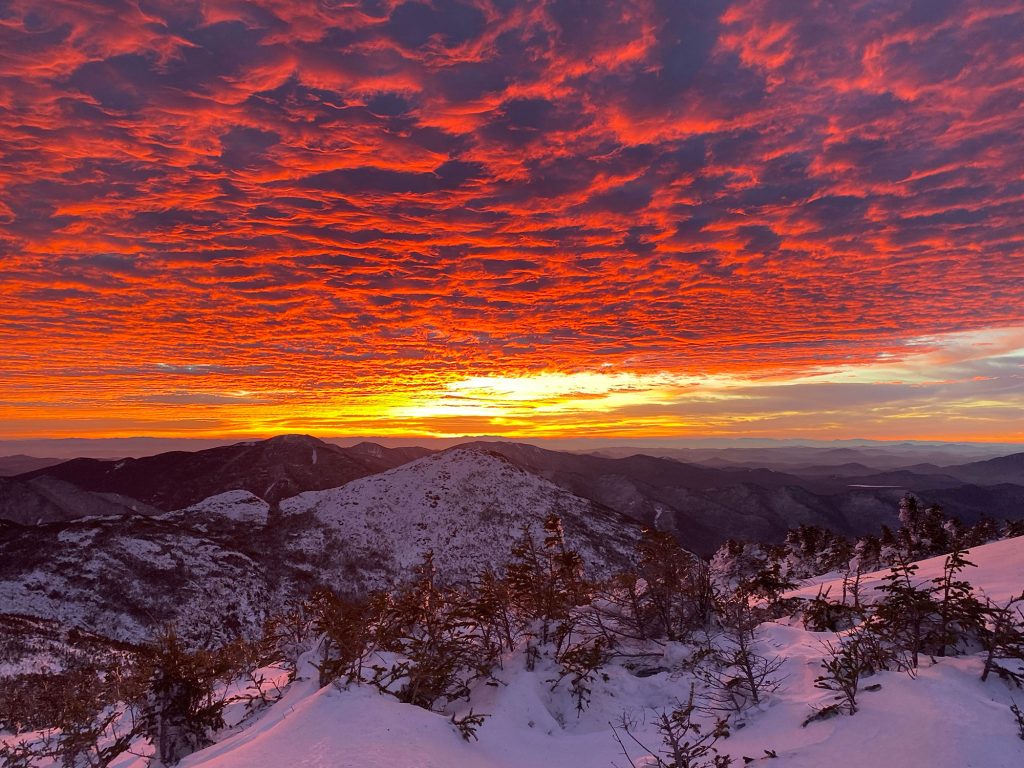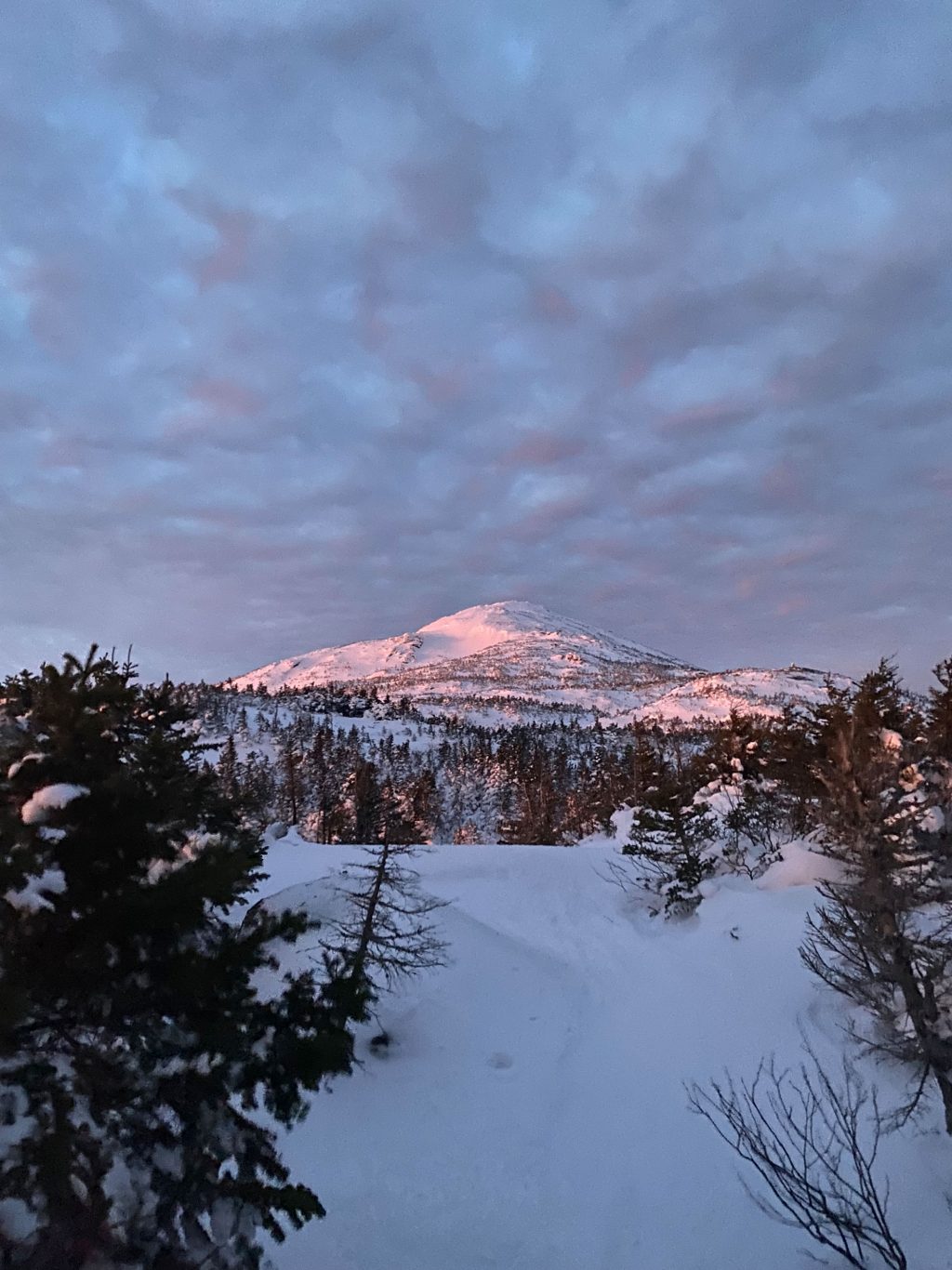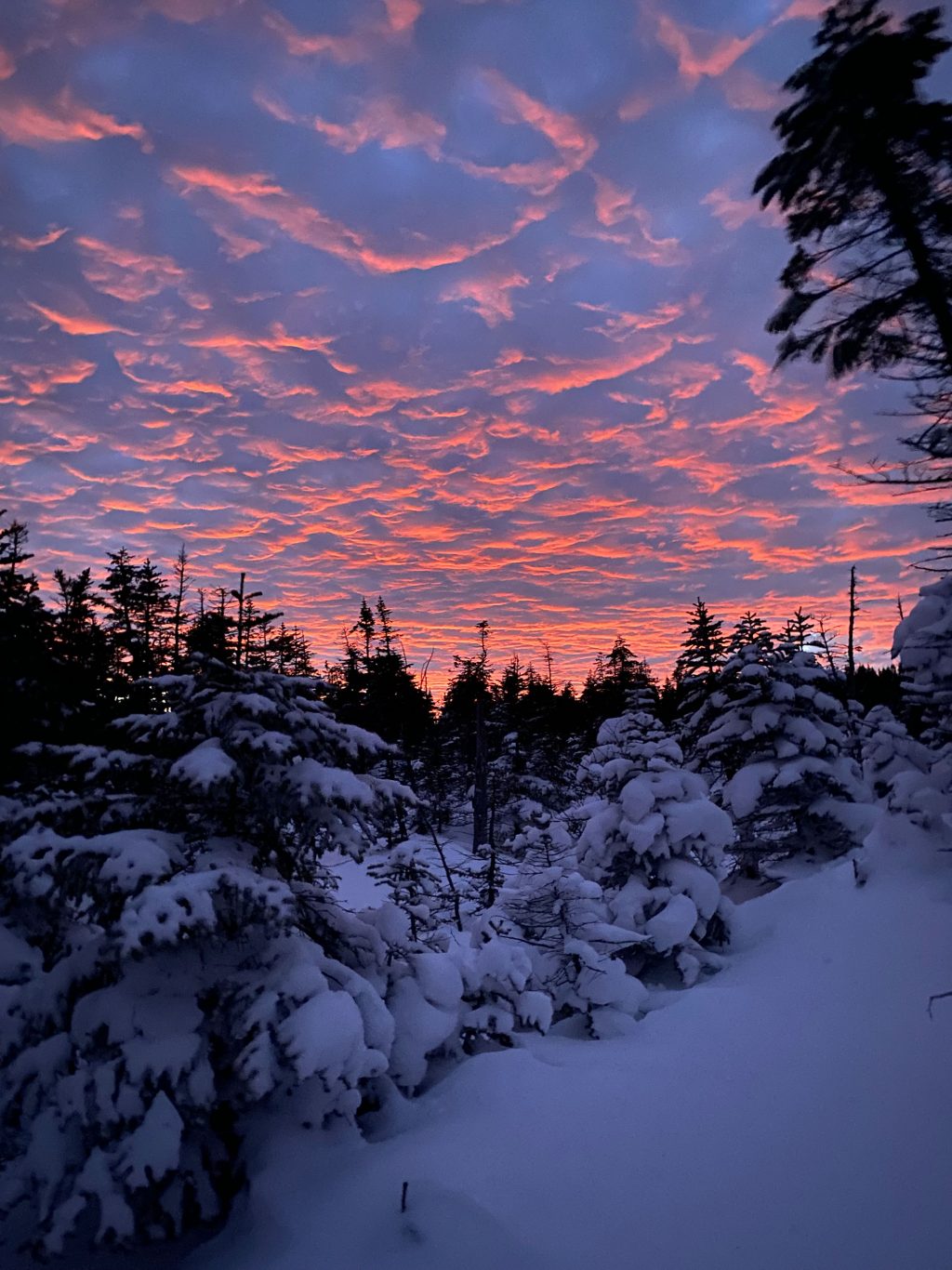“Beep, beep, beep.” For some of you, setting an alarm for 12:30AM might seem insane. For others, it is the beginning of what could become an epic adventure. While I still believe that there are few things that rival the majesty of standing on top of a mountain, being there to watch the first few rays of sunlight crest the horizon can upgrade the entire experience to something legendary. Driving through the night and trekking through the woods illuminated by just your headlamp will test even the savviest of outdoor adventurers. But doing so in the dead of winter? Let the challenge begin.
For all the other dopamine chasers out there, sunrise hikes have become one of my favorite ways to explore the Adirondacks. I’ve grown to love not only hiking through the wee hours of the morning, but the entire experience leading up to catching those summit views. In the words of Conrad Anker, “The summit is what drives us, but the climb itself is what matters.” From the preparation the night before to deciding when to set out on the trail, few things have tested my logistical prowess more than chasing a sunrise, and I’ve used the following tricks and tips to help make the most out of each expedition.

Prepping For Your Sunrise Hike
These missions require a little more preparation at home before hitting the trail.
Know Your Route
If you are new to sunrise hiking, it helps to tackle a peak that you are familiar with. Blazing trail in the daytime can be tricky enough as it is, and when time is of the essence (and the lights are off), it can be easy to make a wrong turn. Take some extra time studying the trail map in advance (and use GPS assistance as needed) to make sure you make it to your destination point.
Know the Weather
It goes without saying that in order to catch a sunrise, there has to be… sun. If the forecast shows gray skies and precipitation, you might want to put your alarm on snooze. But understand that the weather goes beyond catching optimal views, and you should be able to answer the following questions before stepping foot on the trail:
- What is the temperature (including wind chill) projected to be?
- Has there been any precipitation in the last several days?
- Is there any precipitation projected for the day of the hike?
Winter hikes are going to be cold, but simply Googling “Lake Placid weather” will not give you a clear picture of summit temperatures. I personally use Mountain Forecast a few days to even hours leading up to the hike to get the most accurate understanding of what the elements are going to be. If it snowed recently, be prepared to break trail (and it doesn’t hurt to check some of the online forums to see if anyone has attempted the hike to blaze a path for others), and if it has rained or thawed out the day before, be prepared for slippery conditions from the overnight freeze. And while you should always be prepared for the worst, knowing if there will be any substantial weather approaching you during your descent may sway how long you stay on the summit or if you possibly choose to hike another day.
Know Your Time
Are you a morning person? If not, you better get the coffee ready. Your wake up time, morning routine, and travel time all have to be calculated. Knowing what you are going to wear and what you are going to eat can save you a few extra minutes as well. If you are driving to the trailhead from out of town, make sure you know the amount of time it will take for you to get there and provide yourself with some wiggle room.
Know Your Gear
It goes without saying that winter hiking requires a little more gear prep than your typical day hike. Make sure you have the appropriate clothing, footwear, including microspikes, snowshoes (which are required in the ADKs when there is 8+ inches of snow), and possibly crampons, navigation equipment, nutrition, and the list goes on and on. One of the most important things to include would be a headlamp (I always bring two), and extra batteries. Nothing puts a damper on your summit success like dying batteries with hours of hiking left to do. In addition, your pack should be packed the night before (and be familiar with where you put everything as searching through your entire pack in the middle of the night is not ideal).
Know Your Pace
One of the most important things to figure out before you set your goals on a mountain sunrise is your hiking speed. Why is this so crucial? Well, if you average 1 mile per hour and it is a 5-mile hike to the summit, then you are looking at a minimum of 5 hours of hiking. Throw in a few rest breaks, time to check your navigation, and the inevitable fatigue of ascending a mountain and you may find yourself missing golden hour.

Putting it all Together
So, what does this look like in action? Well, here was the game plan and thought process that led to one of the best sunrise hikes that I have ever experienced this past December:
- Weather Prep: Heavy snows hit the Adirondacks a week before my planned hike, but careful weather monitoring (and checking some of the online Facebook groups) led me to believe that the trails to Mount Marcy would be broken in. The forecast showed summit temperatures in the low 30s with a windchill in the teens (with gusts up to 50 miles per hour), but otherwise a clear morning.
- Trail Prep: This would be my third sunrise hike of Marcy this year, so I felt pretty confident in my navigation skills (and the trail is well marked).
- Gear Prep: Going with the Boy Scout motto of “be prepared,” I made sure to have extra layers, water, food, and all of my other 10 Essentials.
- Training Prep: Being a 46er (and having summited many of the High Peaks multiple times), I’ve learned that I am a comfortable 2+ mph hiker. It is roughly 8 miles to the summit of Marcy, and knowing it took 3 hours and 15 minutes to sunrise the peak earlier in the summer, I gave myself a 4 hour window to make it to the top.
- Time Prep: The sunrise was projected to rise at 7:32AM, which meant some of the best light would be ~20-30 minutes before that. Target time to be on the summit: 7:15AM (once again, if you get there too early, you’ll freeze… too late, and you missed the show). This is where the fun begins (flashback to high school math class and trying to find out when two trains would intersect if they left from different cities). Assuming a 4-hour hike, I would want to be strapping on my microspikes at 3:15AM. Knowing I had a 2-hour and 15-minute drive to the Adirondack Loj, I would need to leave the house no later than 1:00AM. My clothes were laid out, breakfast was prepped, and my bag was good to go, so I figured a 12:30AM wake up would do the trick.

The Hike
Now that all the hard stuff was done, all that was left was to start walking. Now there are countless tips and pointers that winter hikers should take use, but the following are a few of my favorite:
- “Be bold, start cold.” You’ll be tempted to layer up as soon as you step out of your warm car and are hit with that first crisp breeze, but with winter hiking, remember that sweating can be dangerous. Not knowing how long you are going to be standing on the summit waiting for the sun to poke its head over the horizon means you do not want to be drenched at the top, so be strategic when figuring out your clothing layers.
- Hydration, hydration, hydration: I always try to drink plenty of fluids on my drive to the trailhead. Knowing that I may be pressed for time during the hike, the last thing I’d want would be to be dehydrated before starting to tack on the vertical gain. Especially because winter hydration is a whole different animal. We often do not have that sense of thirst as much during winter activities, so make sure you schedule in strategic water breaks (I personally stop every hour to drink which keeps me cramp free). Worried about your water freezing? Place your bottles upside down in a sock to prevent the mouth of the bottle from icing over.
- Check the Plan: While not purely a winter hiking tip, I have several mental “checkpoints” picked out throughout my hike to make sure that I am sticking to my pace and the game plan. Once again, making it to the top of the mountain too early can have its downsides, so faster hiking isn’t always better.
The Reward
The thrill of the chase is one of the reasons I love the outdoors. Every hike is unique, and every view is one of a kind. Not knowing what the cloud cover will look like, what colors may paint the sky, or what surprises await you along the trail keep me coming back for more. And while you may strike out a few times and catch some unexpected cloudy days or may have hit snooze one too many times, when it all comes together you may be left speechless.
Tim Reynolds
Tim Reynolds of Ithaca, NY is an assistant professor at Ithaca College and a local physical therapist. An avid outdoorsman, Tim has a passion for hiking the many mountains of the Northeast.
Related Posts
April 2, 2024
10 Tips for Mountain Biking Etiquette During Mud Season
One rough spring could ruin the…




